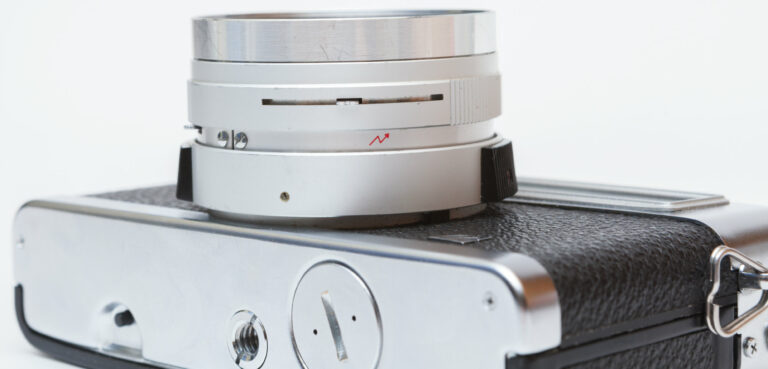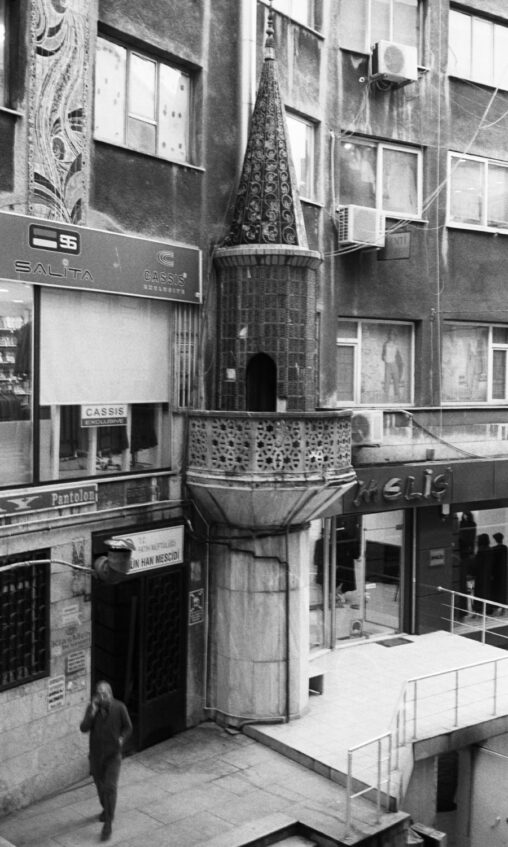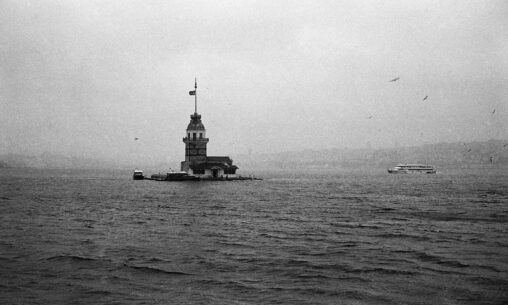I long wanted to try out Yashica Electro 35 rangefinder film camera. One could say that it was my childhood dream, even before I knew about this camera’s existence. One of my two grandfathers, an ardent photo enthusiast, allowed me to use his rangefinder Kiev-2, which was actually a copy of pre-WWII Contax II camera, saying that it is very easy-to-use for shooting. He told me:
You look into the viewfinder, adjust the focus dial to combine the rangefinder focusing patch with the main image. It is very simple and convenient.
I looked into the viewfinder, turned the focusing dial, suffering but unable to understand how to combine them together. But, most importantly, I asked myself the question of “why should I do this at all if it is possible to simply get an SLR camera which is a way easier to operate”. But my grandfather repeatedly tried to convince me that the rangefinder camera is much more convenient when it comes to shooting and is better overall.
Most likely, at that time I was not mature enough for using the rangefinder camera. But, if then I had managed to get hold of Yashica Electro 35, I think I would have had a completely different impression from shooting with the rangefinder camera and would understand that it is good and enjoy the photoshoot. But as a result, for years I have been convinced that rangefinder cameras are not very handy until I got hold of a Yashica Electro 35 GL.
Yashica Electro 35 GL
There is no point in describing its specification in much detail as this is what a user manual is for. All cameras of the Electro 35 family are very similar to each other, you can take any of them and shoot well with it. Most models have almost identical characteristics.
Yashica Electro 35 cameras are a typical representative of their generation — that of a manual focus rangefinder camera with a fixed lens, aperture-priority auto exposure mode, and manual film advance.
Thus, you set the aperture or choose one of the symbols, each of which corresponds to aperture on the lens barrel: Indoor — F1.7-2, Cloudy — F4, Sunny — F11; focus the lens and depress the shutter release button.
Electro 35’s electronic shutter operates a stepless range of speeds from 1/500 to 8 sec.
I eventually chose Yashica Electro 35 GL as it has a few features making this model most advanced among the entire Electro 35 series:
1. A bit wider 40mm lens instead of the common 45mm in other Electro 35s. It seems that the difference is not noticeable but in fact, it makes it closer to a 35mm lens.
2. An exposure meter sensor was moved inside the lens filter thread allowing exposure metering with the filter. This change is the most important in my view. It allows using almost all filters, like Y2 or ND, without making exposure compensation by setting the film speed dial to an appropriate value.
3. Film speed was increased up to 1600 ASA/ISO instead of the common 800-1000 ASA/ISO in other models. This is another valuable addition. Because I would prefer to speed up 400 ISO film by 2EV, i.e. to 1600 ISO, but not to 1000 ISO.
Almost all of these features were removed in superseding models. However, all that I am saying is fair for the entire Yashica Electro 35 series.
Battery
All Yashica Electro 35s are electronically controlled cameras and will not work without a power supply. When the shutter release button is depressed halfway it activates the exposure system; when fully pressed, it triggers the shutter.
Yashica Electro 35s are fitted with Mallory PX32 5.6V mercury battery, whose manufacturing was discontinued many years ago. There is an alkaline equivalent of this battery but it is quite expensive and impossible to find in any retail store. I do not see any reason to order this alkaline battery from eBay or any other online store.
The closest equivalent to PX32 in terms of size and voltage is PX28A 6V battery or 4pcs of LR44 button cells also making 6V. But the size of either of them is still smaller than that of the original PX32 battery.
To install these battery one needs a special adapter which luckily was part of my camera kit. This adapter can be easily found on eBay and costs roughly $4-5. To make contact between the PX28A battery and the battery compartment cover better I put some aluminum foil on the cover. It is easy to DIY the same adapter from cardboard, glue tape, and aluminum foil.
To check the battery power, press the battery check button, the lamp built into the frame counter will light up if the battery has enough power.
However, the discharge curve of alkaline batteries is non-linear in contrast with that of the mercury battery. This means that the exposure meter of the Electro 35 camera might start working inaccurately much earlier. Thus, it is necessary to check the battery power more often, and when the lamp light becomes dimmer it might be better to replace the battery before it completely fails the power check.
Also, the power of an alkaline battery drops significantly in cold weather. As a result, you get an underexposed film. In my case, it was about -2EV when I was in Istanbul in December just before Christmas. I brought back several film rolls and the first two I developed were too transparent. I was required to push the next roll by +1EV, and all the remaining rolls — by additional +1EV, making in total +2EV for the rest of them. The battery was fresh but I spent most of the time roaming city streets with the camera hanging on my neck — and its temperature was identical to that outside, which was about 7°C.
So, I think the silver-oxide batteries, 4SR44 or 4 pcs of SR44 button cells, might be a better replacement for the PX32 mercury battery because the silver-oxide batteries have a similar discharge curve. But it should be tested.
Despite all this, all Yashica Electro 35s are completely electronic cameras, it is still possible to use them without a battery. In this case, the camera shutter fires only 1/500 sec.
Aperture priority auto-exposure mode
When the shutter release button is depressed halfway, it activates the camera’s light meter, which determines the shutter speed for a given f-number. But the photographer does not know the actual shutter speed set by the camera.
In case of overexposure, when the possible shutter speed exceeds 1/500 sec, which is the fastest shutter speed permitted by the camera, the red “OVER” exposure indicator lamp (with the right arrow) lights up on top of the camera and in the viewfinder. There is no underexposure indicator, but when the shutter speed is slower than 1/30 sec, the yellow “SLOW” exposure indicator lamp (with the left arrow) lights up.
However, the same principle of auto exposure mode is the main drawback of all Yashica Electro 35s because you do not understand what shutter speed your camera will set in reality. In a normal situation, when there is enough light, this factor is of little importance. When the “OVER” indicator lamp lights up, you need to narrow the aperture until the “OVER” indicator lamp is turned off. In most cases, I did not set the aperture even at F16.
However, when the “SLOW” indicator lights up, this may mean any shutter speed — from 1/30 to several seconds. And it is possible to take handheld photos using 1/30-1/15 sec shutter speed and in some cases 1/8 sec thanks to no flipping mirror and leaf shutter. But at a slower shutter speed, you would most likely have doubts whether to do this at all as you won’t have any other information about it, beyond the fact that it will be about 1/30 sec or slower.
The easiest solution will be to open up your aperture if it is at all possible. But in case of low light, the yellow “SLOW” indicator may fail to turn off even with a wide-open aperture. Anyway, the exposure should be correct, but you cannot be sure if the shutter speed is enough to take a handheld shot or not.
I often had similar situations when I had to open up the aperture up to F1.7 even while using the 800 ISO film roll despite the fact that the “SLOW” indicator was on. It is anyway you who get to choose whether to shoot or not to shoot. This camera, however, doesn’t have a fully manual mode: you cannot set the exposure you would like to use in given conditions, expecting to later improve the shot during printing or scanning.
Every time I pressed the shutter release button when the yellow lamp was on, I hoped the shutter speed would be fast enough or at least 1/8 sec, allowing me to shoot without a noticeable shake. However, from time to time, quite a few photos turned out to be a bit blurry. But I cannot but admit that some of them were very interesting — but this is, unfortunately, absolutely unpredictable.
Viewfinder
After my experience with the Kiev-2 camera, the viewfinder of Yashica Electro 35 GL was great: it is very bright, and the yellow focusing patch of the rangefinder is well-sized and clearly visible in most lighting conditions.
And the most important option of the Electro 35 rangefinder is that it self-adjusts for parallax: the image frame in the viewfinder moves to the bottom right corner when the focusing distance becomes closer to the subject until reaching 0.8m, a minimum focusing distance.
Summary
You could get an impression that this camera is full of drawbacks. But this is not exactly the case, Yashica Electro 35 GL is a great camera. And the issue of slow shutter speed is not a common occurrence in normal situations when there is enough light. Now I would prefer to get something similar but with an option to set the exposure manually, like Canon Canonet G-III QL17 or Konica Auto S2. Yashica Electro 35 costs much cheaper, and it is without a doubt worth its money.
It has an excellent sharp and fast 40mm F1.7 lens with pleasant bokeh, which has an ideal angle of view for classic street photography. The lens is single coated and equipped with a 5-blade aperture typical for such cameras. The front element of the lens is recessed into the body preventing the lens flare in most cases.
Overall, Yashica Electro 35 is a handy and compact camera, unnoticeable to others. You can wear it on a lanyard on your wrist, and it easily fits in a pocket and can be hidden while being completely ready to be put into action. In this case, you’d better not turn it off as the exposure system drains the power only when the shutter release button is depressed.
Yashica Electro 35 GL resources
- Yashica Electro 35: The “Pad of Death”
- Yashica Electro 35 GL by Photo Thinking. I recommend reading this solid and helpful review
- Video on how to modify batteries for Yashica Electro 35
- Yashica Electro 35 GL page by Mike Butkus
P.S.
Thanks for reading! I would be very grateful if you point out my possible mistakes, add extra information, or just share your experience. Scroll down to the Leave a reply section and share your thoughts about it. Your opinion is important for me. I enjoy answering your questions as the answers may often benefit many other readers and the process of answering allows me to better piece together my existing knowledge and find ideas to improve my articles.

































Jim Grey
Such lovely results from this camera. I wonder how many Electros go unused because of the odd batteries they require.
Sasha Krasnov
Thank you! Not only Electros 😉
Marcel
It was my first camera. Unfortunately I lost it or threw it away, I don’t know anymore, probably when I bought my Pentax spotmatic in the early 1970s.
I also regret having separated myself from the majority of my film cameras in the early 2000s. For 10 years now I have started analog photography again and very much regret having sold my leicas, my bronica and my rolleiflex … sad…
Sasha Krasnov
Forget about it, a more photos ahead! Btw, you make a great pinhole image!
dashy
Thank you, just bought one today, and I will keep referencing back to your blog to ensure I get things correctly.
Sasha Krasnov
Thanks for reading the article! You have made a great choice 😉
Chris Whelan
Excellent post about one of Yashica’s most popular cameras in their rangefinder series. I’ve never had much luck with these types of cameras – I personally prefer the Yashica TL Electro X as my go-to camera. Of course, the TL Electro X is far from being a good street camera unless you’re sitting on a bench with the camera prefocused and the aperture and shutter preset. I had great success while shooting in Japan in and around busy train stations.
I enjoy your blog and photography very much. Keep up the good work. – Chris
Sasha Krasnov
Thank you, Chris, for the feedback. I’ve not had too much luck with it also — the rangefinder focusing is still a challenge for me. My eyesight has deteriorated lately and I’m switched back to Pentax MZ-6 autofocus camera.
Nick
Hello Sasha,
Amazing article 🙂 It helped me a lot and I enjoyed reading it.
I have a Yashica Electro 35 myself, but I believe the battery door is broken. The metal part of it has been ripped off and there is only the black plastic part left.
Do you think I can repair it (because I cannot find a replacement battery door)? If I remove the plastic part completely and put aluminum foil, will it work?
Thanks in advance!
Sasha Krasnov
Hello Nick,
Thank you so much for reading the article! I guess you could try filling the space remaining from the lost door with aluminum foil and fixing it with gluing tape. Why not try this?
Primo
Ho tutta la serie delle Electro 35 fino alla MG1 del 1975, sto cercando le successive.
Zdenko
Ja imam electro 35 GL
Zdenko
Ja imam yashica electro 35 gl / series 1974
Sasha Krasnov
Such a great collection you have!
Andy
Hi Sasha,
I’m Andy from indonesia. I would like to know your opinion about Yashica Electro 35GL amongs Electro 35 products.. What are the advantages and disadvantages of this product.. thanks
Sasha Krasnov
Hi, Andy!
As outlined in the article, the Electro 35GL’s key features include a lens-integrated exposure meter, a slightly shorter focal length, and a maximum film speed of 1000 ISO.
Raju BR
Very nice subject i understand and past (old)memories thanks lot
Sasha Krasnov
Appreciate you taking the time to read the article!
ssspinterest website
Loved this review! The sample images you’ve included really showcase the character of the Yashica Electro 35 GL. It’s interesting to see how its unique features impact the photos. Makes me want to pick one up and give it a try myself!
Sasha Krasnov
Yashica Electro 35 family cameras are the most inexpensive among others. You can easily sell it for the same money after playing for some time.